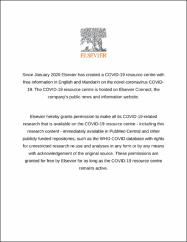| dc.contributor.author | Uçar, Ferhat | |
| dc.contributor.author | Korkmaz, Deniz | |
| dc.date.accessioned | 2021-06-03T07:56:03Z | |
| dc.date.available | 2021-06-03T07:56:03Z | |
| dc.date.issued | 2020 | en_US |
| dc.identifier.citation | Ucar, F., & Korkmaz, D. (July 01, 2020). COVIDiagnosis-Net: Deep Bayes-SqueezeNet based diagnosis of the coronavirus disease 2019 (COVID-19) from X-ray images. Medical Hypotheses, 140. | en_US |
| dc.identifier.issn | 0306-9877 | en_US |
| dc.identifier.issn | 1532-2777 | en_US |
| dc.identifier.uri | https://doi.org/10.1016/j.mehy.2020.109761 | |
| dc.identifier.uri | https://hdl.handle.net/20.500.12899/178 | |
| dc.description.abstract | The Coronavirus Disease 2019 (COVID-19) outbreak has a tremendous impact on global health and the daily life of people still living in more than two hundred countries. The crucial action to gain the force in the fight of COVID-19 is to have powerful monitoring of the site forming infected patients. Most of the initial tests rely on detecting the genetic material of the coronavirus, and they have a poor detection rate with the time-consuming operation. In the ongoing process, radiological imaging is also preferred where chest X-rays are highlighted in the diagnosis. Early studies express the patients with an abnormality in chest X-rays pointing to the presence of the COVID-19. On this motivation, there are several studies cover the deep learning-based solutions to detect the COVID-19 using chest X-rays. A part of the existing studies use non-public datasets, others perform on complicated Artificial Intelligent (AI) structures. In our study, we demonstrate an AI-based structure to outperform the existing studies. The SqueezeNet that comes forward with its light network design is tuned for the COVID-19 diagnosis with Bayesian optimization additive. Fine-tuned hyperparameters and augmented dataset make the proposed network perform much better than existing network designs and to obtain a higher COVID-19 diagnosis accuracy. | en_US |
| dc.language.iso | en | en_US |
| dc.publisher | Elsevier | en_US |
| dc.relation.ispartof | Medical Hypotheses | en_US |
| dc.rights | info:eu-repo/semantics/openAccess | en_US |
| dc.subject | Coronavirus Disease 2019 | en_US |
| dc.subject | SARS-CoV-2 | en_US |
| dc.subject | Rapid Diagnosis of COVID-19 | en_US |
| dc.subject | Deep learning | en_US |
| dc.subject | Bayesian optimization | en_US |
| dc.title | COVIDiagnosis-Net: Deep Bayes-SqueezeNet based diagnosis of the coronavirus disease 2019 (COVID-19) from X-ray images | en_US |
| dc.type | Article | en_US |
| dc.authorid | 0000-0002-5159-0659 | en_US |
| dc.department | MTÖ Üniversitesi, Mühendislik ve Doğa Bilimleri Fakültesi, Elektrik-Elektronik Mühendisliği Bölümü | en_US |
| dc.institutionauthor | Korkmaz, Deniz | |
| dc.identifier.doi | 10.1016/j.mehy.2020.109761 | |
| dc.identifier.volume | 140 | en_US |
| dc.identifier.startpage | 1 | en_US |
| dc.identifier.endpage | 12 | en_US |
| dc.relation.publicationcategory | Makale - Uluslararası Hakemli Dergi - Kurum Öğretim Elemanı | en_US |
| dc.identifier.pmid | 32344309 | |
| dc.identifier.scopus | 2-s2.0-85083721797 | en_US |
| dc.identifier.scopusquality | Q2 | en_US |
| dc.identifier.wos | WOS:000540720800018 | en_US |
| dc.identifier.wosquality | Q4 | en_US |
| dc.indekslendigikaynak | Web of Science | en_US |
| dc.indekslendigikaynak | Scopus | en_US |
| dc.indekslendigikaynak | PubMed | en_US |


















